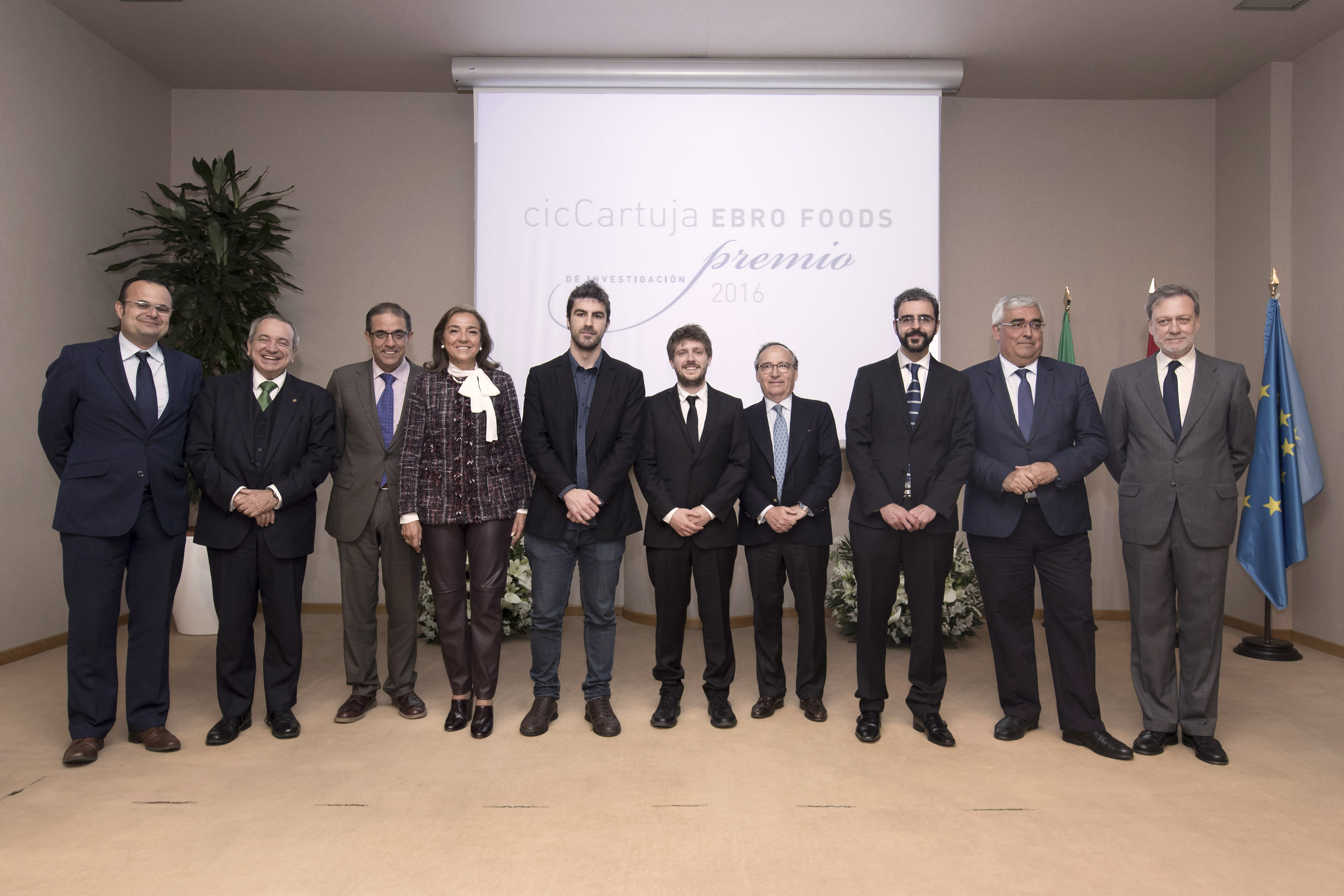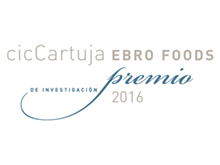Seville, April 28, 2017. Miguel Anaya Martín has won the seventh edition of the “cicCartuja – Ebro Foods” Award thanks to his proposal for solar devices based on ABX3 perovskites. This award recognizes the work carried out by young researchers under 31 years of age who have previously published scientific articles in prestigious international journals related to areas such as Chemistry, Biochemistry or Materials Science.
The cicCartuja–Ebro Foods Award ceremony took place this morning in the Assembly Hall of the Isla de la Cartuja Scientific Research Center (cicCartuja). The event was attended by authorities from the world of science and the university environment, as well as from industry and local, regional and national politics. Among them, the Secretary of State for Research, Development and Innovation, Carmen Vela; the Minister of Economy and Knowledge, Antonio Ramírez de Arellano; the President of the CSIC, Emilio Lora-Tamayo; and the Rector of the University of Seville, Miguel Ángel Castro.
For his part, as director of cicCartuja, Miguel Ángel de la Rosa has highlighted the “multiple objectives” of the cicCartuja-Ebro Foods Award, becoming over time “a key piece in the strategy designed to make the scientific activities of cicCartuja known to society, companies and the general public”.
All the authorities have agreed on the effort and the value of young talent and on the importance of science for the evolution of Spain, where 15% of European scientific projects are coordinated. The President of Ebro Foods, Antonio Hernández Callejas, has claimed the role of the private company in R&D&I, being on many occasions the investment engine of initiatives such as the award granted today.
For his part, the Minister of Economy and Knowledge, Antonio Ramírez de Arellano, has announced during the event the future implementation of the Andalusian Research Plan. This measure includes, among other aspects, the inclusion of excellence plans aimed at research, the announcement of 1,300 contracts for people under 30 years of age in Andalusian universities or the simplification of bureaucratic procedures.
Miguel Ángel Castro, rector of the University of Seville, has stressed that quality scientific publication is “a personal achievement” and that “large infrastructures are of no use without the work of our researchers”. Castro has also thanked all the award winners for making scientific talent an “institution” and has taken the opportunity to announce his intention to expand his collaboration agreements with the Higher Council for Scientific Research (CSIC), news celebrated by the President of the CSIC, Emilio Lora-Tamayo.
Finally, Carmen Vela, Secretary of State for Research, Development and Innovation, has shared with all the attendees her enthusiasm for initiatives such as this and has emphasised the social nature of science, conceived by and for citizens.
Optics propels perovskite solar cells towards new horizons
Miguel Anaya has written the first of the articles awarded in this seventh edition of the Prize. Published in Advanced Materials, one of the scientific journals with the highest impact in the field of Materials Science, this article presents a broad study of perovskite solar cells. Thanks to the optical designs proposed by Anaya and his research group, devices with efficiencies close to 21% have been achieved, a value very close to the physical limits and a scientific milestone today.
Since 2012, perovskite solar cells have revolutionised the field of photovoltaics, as they can compete directly with technologies as well established in our lives as silicon solar cells.
According to a special report produced by the World Economic Forum, perovskite and its applications are among the top 10 emerging technologies of 2016. There are three reasons that support this argument: its production, which is simpler, cheaper and less polluting than silicon; its efficiency, with which record figures can be achieved; its lightness and flexibility, which makes cells based on this material ideal for integration into buildings with any geometric shape.
Miguel Anaya, who is currently linked to the ICMS Multifunctional Optical Materials research group, has also resolved in his article the lack of stability that has been characterizing these materials, a fact that represents a further step towards their intended industrialization and towards the establishment of this new technology whose progress is vertiginous. Currently, this line of research is established as one of the most active fields in Materials Science.
A sensor for monitoring fermentation processes
The second award-winning work was written by researcher Manuel Oliva Ramírez and was developed in the Surface Nanotechnology Group of the ICMS, led by Agustín Rodríguez González-Elipe. Currently, Oliva is employed as a postdoctoral researcher at the Leibniz Institute for New Materials in Saabrücken, Germany.
His article, published in the ACS Nano journal, has earned the first prize in the “cicCartuja – Ebro Foods” Award, thanks to the design of a microfluidic device that determines the concentration of sugars in liquids during fermentation processes. This fact is very important, since the quality control and transformation of liquids in the food industry are basic activities. In addition, the model proposed by Oliva and his group is characterized by not using additives in the process of analyzing liquids and solutions.
From an industrial perspective, the fundamentals of this device have been protected by a patent and a pre-commercial prototype with automatic operation has already been built, which has been successfully tested. Its industrial transfer is currently being negotiated by the CSIC and there are currently several companies interested in acquiring it for real applications.
Transforming CO2 in a controlled and efficient way
Finally, the second runner-up prize in the “cicCartuja – Ebro Foods” Award has been awarded to Pablo Ríos Moreno from Seville, a researcher at the Institute of Chemical Research and attached to the group ‘Design of organometallic molecules and applications’. Ríos, whose article appears in ACS Catalysis, has developed nickel catalysts, a cheap and abundant metal on earth, capable of obtaining formaldehyde –derived from CO2- in a selective manner.
Formaldehyde is a highly useful compound, both in industry and in research laboratories, as it is used, among other processes, in the manufacture of disinfectants, in the pharmaceutical and textile industries and even in fuel cell technology.
Despite its great versatility, the synthesis of formaldehyde is not an easy task, hence the importance of the catalyst that Ríos presents in the award-winning article. Being able to synthesize the element in a more environmentally friendly way –lower temperatures and pressures–, it stands as an optimal alternative to the processes currently used in the chemical industry. On the other hand, the use of nickel catalysts means that the process is much cheaper, something that had not been achieved until now, given that current processes entail much higher costs.
Amount of the prize
Since 2010, the Isla de la Cartuja Scientific Research Centre – a joint centre of the Spanish National Research Council (CSIC), the Regional Government of Andalusia and the University of Seville – and Ebro Foods have awarded these prizes to promote the career of young researchers working at cicCartuja. In this seventh edition, the “cicCartuja – Ebro Foods” Prize is worth 20,000 euros, of which 10,000 euros are for the winner, 5,000 euros for the first runner-up and another 5,000 for the second runner-up. These amounts have been donated by the company Ebro Foods, which – through its president, Antonio Hernández Callejas – has supported the scientific excellence of young researchers at cicCartuja and the transfer of knowledge from the laboratory to society.




